|
|
GIZE, STONEHENGE, CHICHEN ITZA, ETC,ETC: PIRAMIDES EN ITALIA
Choisir un autre rubrique de messages |
|
Réponse |
Message 1 de 24 de ce thème |
|
en.wikipedia.org/wiki/Pyramid_of_Cestius
The Pyramid of Cestius (in Italian, Piramide di Caio Cestio or Piramide Cestia) is
an ancient pyramid in Rome, Italy, near the Porta San Paolo and the Protestant ...
www.european-pyramids.eu/wb/pages/...pyramids/italy.php
The existence of ancient lava stone pyramids in Italy has long been known. There
are several terraced lava stone structures in Sardinia and Sicily, excavated ...
news.discovery.com/history/.../etruscan-pyramids-120918.htm
27 Nov 2012 ... The subterranean pyramids found in Orvieto, Italy could offer a unique insight into
the mysterious Etruscan culture. Stairs carved into the wall ...
english.pravda.ru/science/.../122218-underground_pyramids-0/
20 Sep 2012 ... A group of Italian and American archaeologists discovered unique underground
pyramid in the town of Orvieto, Italy, says Utro.ru.
www.tripadvisor.co.uk/Hotel_Review-g187791-d264638-Reviews-Hotel_ Pyramid-Rome_Lazio.html
Calificación: 3 - 238 opiniones - Rango de precios: £
Hotel Pyramid, Rome: See 238 traveller reviews, 79 candid photos, and great
deals for ... Hotel | Via dei Magazzini Generali 4, 00154 Rome, Italy (Ostiense).
|
|
|
|
www.youtube.com/watch?v=icngdHNgYRE12 Abr. 2013 - 7 min. - Subido por MisterNarrador
Mysterious Underground Etruscan Pyramids Found In Italy. |
world-pyramids.com/...pyramids/.../santa-agata-pyramid-hill,-italy.html
Santa Agata dei Goti Pyramid Hill in Italy, close Napoli was discovered in 2008
by local residence Mr. Leonardo Romano. Clear pyramidal sides makes it's ...
www.crystalinks.com/pyramiditaly.html
Pyramids in Italy. The Pyramid of Cestius (in Italian, Piramide di Caio Cestio or
Piramide Cestia) is an Egyptian-style pyramid in Rome, Italy near the Porta San ...
www.anselm.edu/News/Pyramid-Discovery.htm
August 07, 2012. Laura Lemire Communications and Marketing 603-641-7242.
Classics professor David George and a group of Saint Anselm students and ...
www.worldsiteguides.com/europe/italy/rome/pyramid-of-cestius/
The Pyramid of Cestius is located in Rome, Italy. The cemetery is situated in
southern parts of the city, next to the Aurelian Wall and the Pyramid of Cestius.
|
|
|
|
Réponse |
Message 2 de 24 de ce thème |
|
Pyramid of Cestius
From Wikipedia, the free encyclopedia
The Pyramid of Cestius (in Italian, Piramide di Caio Cestio or Piramide Cestia) is an ancient pyramid in Rome, Italy, near the Porta San Paolo and the Protestant Cemetery. It stands at a fork between two ancient roads, the Via Ostiensis and another road that ran west to the Tiber along the approximate line of the modern Via della Marmorata. Due to its incorporation into the city's fortifications, it is today one of the best-preserved ancient buildings in Rome.
Physical attributes[edit]
The pyramid was built about 18 BC–12 BC as a tomb for Gaius Cestius, a magistrate and member of one of the four great religious corporations in Rome, the Septemviri Epulonum. It is of brick-faced concrete covered with slabs of white marble standing on a travertine foundation, measuring 100 Roman feet (29.6 m) square at the base and standing 125 Roman feet (37 m) high.[1]
In the interior is the burial chamber, a simple barrel-vaulted rectangular cavity measuring 5.95 metres long, 4.10 m wide and 4.80 m high. When it was (re)discovered in 1660, the chamber was found to be decorated with frescoes, which were recorded by Pietro Santi Bartoli, but only the scantest traces of these now remain. There was no trace left of any other contents in the tomb, which had been plundered in antiquity. The tomb had been sealed when it was built, with no exterior entrance; it is not possible for visitors to access the interior,[1] except by special permission typically only granted to scholars.
Inscriptions[edit]
A dedicatory inscription is carved into the east and west flanks of the pyramid, so as to be visible from both sides. It reads:
- C · CESTIVS · L · F · POB · EPULO · PR · TR · PL
- VII · VIR · EPOLONVM
- Gaius Cestius, son of Lucius, of the gens Pobilia, member of the College of Epulones, praetor, tribune of the plebs, septemvir of the Epulones [1][2]
Below the inscription on the east-facing side is a second inscription recording the circumstances of the tomb's construction. This reads:
- OPVS · APSOLVTVM · EX · TESTAMENTO · DIEBVS · CCCXXX
- ARBITRATV
- PONTI · P · F · CLA · MELAE · HEREDIS · ET · POTHI · L
- The work was completed, in accordance with the will, in 330 days, by the decision of the heir [Lucius] Pontus Mela, son of Publius of the Claudia, and Pothus, freedman [1]
Another inscription on the east face is of modern origins, having been carved on the orders of Pope Alexander VII in 1663. Reading INSTAVRATVM · AN · DOMINI · MDCLXIII, it commemorates excavation and restoration work carried out in and around the tomb between 1660–62.[1]
At the time of its construction, the Pyramid of Cestius would have stood in open countryside (tombs being forbidden within the city walls). Rome grew enormously during the imperial period, and, by the 3rd century AD, the pyramid would have been surrounded by buildings. It originally stood in a low-walled enclosure, flanked by statues, columns and other tombs.[3] Two marble bases were found next to the pyramid during excavations in the 1660s, complete with fragments of the bronze statues that originally had stood on their tops. The bases carried an inscription recorded by Bartoli in an engraving of 1697:

The pyramid was incorporated into the Aurelian Walls and is close to Porta San Paolo (on the right).
- M · VALERIVS · MESSALLA · CORVINVS ·
- P · RVTILIVS · LVPVS · L · IVNIVS · SILANVS ·
- L · PONTIVS · MELA · D · MARIVS ·
- NIGER · HEREDES · C · CESTI · ET ·
- L · CESTIVS · QVAE · EX · PARTE · AD ·
- EVM · FRATRIS · HEREDITAS ·
- M · AGRIPPAE · MVNERE · PER ·
- VENIT · EX · EA · PECVNIA · QVAM ·
- PRO · SVIS · PARTIEVS · RECEPER ·
- EX · VENDITIONE · ATTALICOR ·
- QVAE · EIS · PER · EDICTVM ·
- AEDILIS · IN · SEPVLCRVM ·
- C · CESTI · EX · TESTAMENTO ·
- EIVS · INFERRE · NON · LICVIT ·
This identifies Cestius' heirs as Marcus Valerius Messala Corvinus, a famous general; Publius Rutilius Lupus, an orator whose father of the same name had been consul in 90 BC; and Lucius Junius Silanus, a member of the distinguished gens Junia. The heirs had set up the statues and bases using money raised from the sale of valuable cloths (attalici). Cestius had stated in his will that the cloths were to be deposited in the tomb, but this practice had been forbidden by a recent edict passed by the aediles.[1]
History[edit]
The sharply pointed shape of the pyramid is strongly reminiscent of the pyramids of Nubia, in particular of the kingdom of Meroë, which had been attacked by Rome in 23 BC. The similarity suggests that Cestius had possibly served in that campaign and perhaps intended the pyramid to serve as a commemoration. His pyramid was not the only one in Rome; a larger one—the so-called "pyramid of Romulus"—of similar form but unknown origins stood between the Vatican and the Mausoleum of Hadrian but was demolished in the 16th century.[1]
Some writers have questioned whether the Roman pyramids were modelled on the much less steeply pointed Egyptian pyramids exemplified by the famous pyramids of Giza. However, the relatively shallow Giza-type pyramids were not exclusively used by the Egyptians; steeper pyramids of the Nubian type were favoured by the Ptolemaic dynasty of Egypt that had been brought to an end in the Roman conquest of 30 BC. The pyramid was, in any case, built during a period when Rome was going through a fad for all things Egyptian. The Circus Maximus was adorned by Augustus with an Egyptian obelisk, and pyramids were built elsewhere in the Roman Empire around this time; the Falicon pyramid near Nice in France was suspected by some to have been constructed by Roman legionaries who followed an Egyptian cult,[4] but more recent research has indicated that it was actually built between 1803 and 1812.[5]
During the construction of the Aurelian Walls between 271 and 275, the pyramid was incorporated into the walls to form a triangular bastion. It was one of many structures in the city to be reused to form part of the new walls, probably to reduce the cost and enable the structure to be built more quickly. It still forms part of a well-preserved stretch of the walls, a short distance from the Porta San Paolo.[6]
The origins of the pyramid were forgotten during the Middle Ages. The inhabitants of Rome came to believe that it was the tomb of Remus (Meta Remi) and that its counterpart near the Vatican was the tomb of Romulus, a belief recorded by Petrarch.[7][8] Its true provenance was clarified by Pope Alexander VII's excavations in the 1660s, which cleared the vegetation that had overgrown the pyramid, uncovered the inscriptions on its faces, tunnelled into the tomb's burial chamber and found the bases of two bronze statues that had stood alongside the pyramid.[1]
The pyramid was an essential sight for many who undertook the Grand Tour in the 18th and 19th centuries. It was much admired by architects, becoming the primary model for pyramids built in the West during this period.[9] Percy Bysshe Shelley described it as "one keen pyramid with wedge sublime" in Adonaïs, his 1821 elegy for John Keats. In turn the English novelist and poet Thomas Hardy saw the pyramid during a visit to the nearby Protestant Cemetery in 1887 and was inspired to write a poem, Rome: At the Pyramid of Cestius near the Graves of Shelley and Keats, in which he wondered: "Who, then was Cestius, / and what is he to me?"[10]
In 2001, the pyramid's entrance and interior underwent restoration. In 2011, further work was announced to clean and restore the pyramid's badly damaged marble cladding, through which water seepage has endangered the frescoes within. The restoration is sponsored by Japanese businessman Yuzu Yakhi, whose €1-million donation resulted in a call for tenders to carry out the work issued by the Soprintendenza Speciale per i Beni Archeologici di Roma [11] whose officials drew up the project and are supervising such an intervention along with the Italy's Ministry of Cultural Heritage.[12] Restoration works started in March 2013.[13]
The pyramid is the namesake of the Piramide station of the Rome Metro.
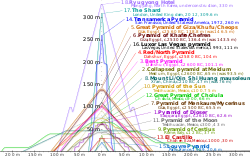
Comparison of approximate profiles of Pyramid of Cestius with some notable pyramidal or near-pyramidal buildings. Dotted lines indicate original heights, where data is available.
References[edit]
- ^ Jump up to: a b c d e f g h Claridge, Amanda (1998). Rome: An Oxford Archaeological Guide, First, Oxford, UK: Oxford University Press, 1998, pp. 59, 364–366. ISBN 0-19-288003-9
- Jump up ^ Di Meo, Chiara: La piramide di Caio Cestio e il cimitero acattolico del Testaccio: trasformazione di un'immagine tra vedutismo e genius loci. Rome: Palombi Fratelli, 2008
- Jump up ^ Lawrence J. F Keppie, Understanding Roman Inscriptions, pp. 104–105. Routledge, 1991. ISBN 0-415-15143-0
- Jump up ^ James Stevens Curl, The Egyptian Revival: Ancient Egypt as the Inspiration for Design Motifs in the West, pp. 39–40. Routledge, 2005. ISBN 0-415-36118-4
- Jump up ^ "La pyramide de Falicon et la grotte des Ratapignata". 2007. Retrieved 2008-09-06.
- Jump up ^ Aldrete, Gregory S (2004). Daily Life In The Roman City: Rome, Pompeii, And Ostia, Greenwood Press, 2004, pp. 41–42. ISBN 0-313-33174-X
- Jump up ^ Eileen Gardiner, Francis Morgan Nichols, The Marvels of Rome, p. 86. Italica Press, Incorporated, 1986. ISBN 0-934977-02-X
- Jump up ^ Augustus J.C. Hare, Walks in Rome, p. 268. Adamant Media Corporation, 2001. ISBN 1-4021-7139-0
- Jump up ^ Jean-Marcel Humbert, Clifford A. Price, Imhotep Today: Egyptianizing Architecture, p. 27. Routledge Cavendish, 2003. ISBN 1-84472-006-3
- Jump up ^ Radford, Andrew (2008). "'Fallen Angels': Hardy's Shelleyan Critique in the Final Wessex Novels". In Radford, Andrew; Sandy, Mark. Romantic echoes in the Victorian era. Ashgate Publishing, Ltd. p. 107. ISBN 978-0-7546-5788-0.
- Jump up ^ "The Restoration of the Pyramid of Caius Cestius". Official Website of the Soprintendenza Speciale per i Beni Archeologici di Roma.
- Jump up ^ "Restoration of Rome's Pyramid". Wanted in Rome. 26 January 2011. Retrieved 28 May 2011.
- Jump up ^ Larcan, Laura (13 March 2013). "Al via il restauro della Piramide Cestia, viaggio all'interno del monumento". Il Messaggero. Retrieved 30 March 2013.
|
|
|
|
Réponse |
Message 3 de 24 de ce thème |
|
|
Pyramids in Italy
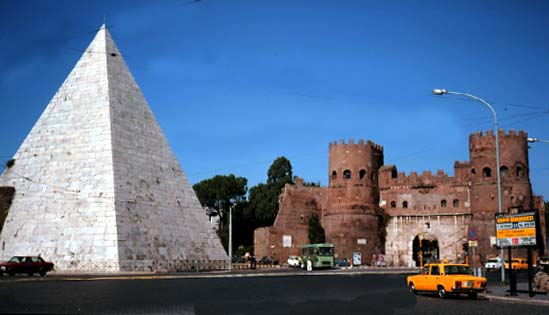
The Pyramid of Cestius (in Italian, Piramide di Caio Cestio or Piramide Cestia) is an Egyptian-style pyramid in Rome, Italy near the Porta San Paolo and the Protestant Cemetery.
The pyramid is a funerary monument built about 12 BC as a tomb for Caius Cestius, a member of one of the four great religious corporations at Rome, the Septemviri epulonum. It is of brick-faced concrete covered with slabs of white marble, 27 meters high and about 22 meters square, standing on a travertine foundation. In the interior is the burial chamber, 5.95 metres long, 4.10 wide and 4.80 high. On the east and west sides, about halfway up, is the inscription recording the names and titles of Cestius, and below, on the east side only, another which relates the circumstances of the erection of the monument (CIL vi.1374).
The peculiar conceit of a pyramid in Rome must be laid to the fact that Rome had conquered Egypt a few years before, in 30 BC, and the ancient culture of the new province became fashionable for a while; at any rate the tomb is unique among ancient Roman monuments, and not until modern funerary architecture did Rome see another pyramid within its walls.
A comparison of their shape reveals that the structural strength of concrete made it possible to build the Roman pyramid at a much sharper angle than those of Egypt.
In the 3rd century the pyramid was included inside the Aurelian Walls, and the Middle Ages, including the author Petrarch, seems to have thought of it, erroneously, as the tomb of either Romulus or Remus, in spite of the inscription.
At that time, it was considered one of the most important monuments of antiquity. It had been conserved 'nearly intact', but was neverhteless overgrown with plants. The inscription 'Caius Cestius' was barely visible. Pier Paolo Vergerio mentioned around 1400 that it was difficult to read because of the vegetation.
In 1660, excavations were undertaken: two statue bases were found outside it dedicated to Cestius, and an opening was dug into the pyramid itself, when it was discovered that the burial chamber was once decorated with frescoes, only the scantest traces of which now remain.
The Falicon pyramid near Nice in France is suspected by some to have been constructed by Roman legionaries from an Egyptian cult.
References and Links
Three Pyramids Discovered In Montevecchia, Italy
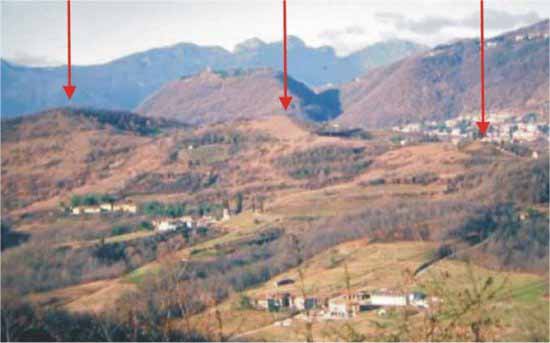
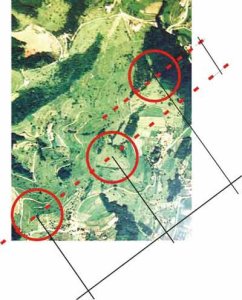
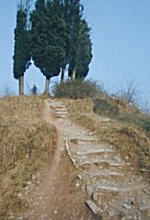
Discovered May 2, 2003, from the air over northern Italy, 40 km from Milan, were three pyramids, with the same alignment as Giza and Orion. They are the first pyramids ever discovered in Italy and the dimensions are quite impressive. The highest pyramid is [500 feet] tall. They are stone buildings, as recent excavations have proved. However, they are now completely covered by ground and vegetation, so that they look like mounds.
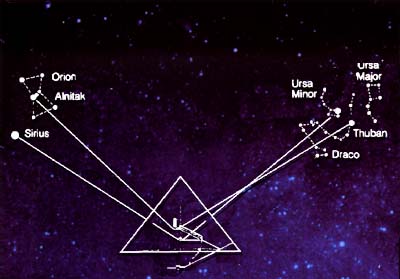
Sirius
Orion
The inclination degree of all the three pyramids is 42/43¡ and there is a perfect alignment with the Orion constellation. Nothing was found nearby which may help to date the structures and in the area there was not any civilization able to build similar structures at the time. The people who lived there were mainly gatherers and hunters.
Reference
ShareThis
ANCIENT ROME
PYRAMID INDEX
SACRED PLACES AND TEACHINGS INDEX
ANCIENT CIVILIZATIONS INDEX
ALPHABETICAL INDEX OF ALL FILES
CRYSTALINKS HOME PAGE
PSYCHIC READING WITH ELLIE
2012 THE ALCHEMY OF TIME
|
|
|
|
Réponse |
Message 4 de 24 de ce thème |
|
MONTEVECCHIA ... research trip Oct.2007
located about 40 km northeast of Milan and about 15 km south of Lecco in Lombardy/Italy there is a small village with 3 pyramid shaped hills. These hills in Montevecchia were discovered in 2003 by the Italian architect Vincenzo DeGregorio.
See links in ITALIAN: http://www.croponline.org/montevecchia.htm http://www.antikitera.net/download%5CPiramidi_Brianzole.pdfhttp://www.duepassinelmistero.com/Pirmontev.htm ...DeGregorio report
If it is true, what Vincenzo DeGregorio could see with his balloon camera, these hills, the highest 150 m, would be gigantic pyramids. Even higher than the Giza pyramids in Egypt (once 146 m). The Czech magazine WM 2003 has published a report about their research in May 2003.

areal foto of the Montevecchia pyramid-hills
In early 2003, the pyramids of Montevecchia (“Old Mountain"), ca. 30 miles from the Italian city of Milan, were discovered through the use of satellite and aerial imagery. These pyramids are now completely covered by ground and vegetation and appear to be natural hills, but the possibility of something more was enough for the Czech WM magazine and their editor in chief Georg Wojnar to visit the area. They arrived on May 8, 2003, in an effort to locate and survey the site. The team soon learned that discovering their location from the ground proved more difficult than imagined, with the team becoming impressed with the driving abilities required to negotiate the roads that lead towards the hills. After two days of failed attempts, they finally succeeded in locating the pyramids and carrying out an initial survey.
The team’s conclusion appeared in the June 2003 issue of WM. They had come to the conclusion that the first pyramid was estimated to have a base of 100 metres, with a height of 50 metres. In total, three potential pyramids were surveyed, with one pyramid showing clear signs of stones worked into the structure, close to the surface. A platform with an oblong superstructure with a size of 18 by 9 metres was also discovered. All three structures had an inclination of 42/43 degrees. The sides of all pyramids were aligned and were offset from the cardinal points by approximately 7 to 12 degrees northeast. The team wondered whether this was an error in design or a sign of something more intriguing. From the initial aerial surveys, there was speculation that their layout compared to the pyramids of the Gizeh plateau – and thus to the Belt of Orion. The Czech team stated that their on-site research had showed that the pyramids actually aligned with the passing of Orion at the sunrise of the summer solstice. The Czech team felt that the site should be known as “the Italian Gizeh".
Gabriela Lukacs and fellow researcher Nenad Djurdjevic from Bergamo made a research trip to Montevecchia in October 2007.
We presented our investigations on ICBP-conference in Sarajevo Aug.2008
The 3 pyramidal hills are best seen from the little town of Montevecchia. The old town itself is located on a hill with the Carmelite monastery situated on the tallest hill top. And this was a big surprise to us: this area is a huge basin with 7 to 9 pyramidal hills surrounding it. The 3 hills detected and determined as pyramids by V.DeGregorio can easily be seen and are not the only ones in the area!
Our research brought up 13 surprises and a new approach to the "Montevecchia" hills:
- 7-9 pyramid shaped and terraced hills can be seen in the area of Montevecchia.
- Not only are their pyramidal shapes clearly visible, but also the steps, edges and flattened tops.
- 2 hills are parallel and their sides are aligned with a slight offset of 7-12° to the cardinal directions. 1 hill slightly different in position and alignment.
- The stepped ascent paths to the tops follow the edges on the SE+SW sides.
- All 3 hills are connected with each other by a path N-S, respectively S-N.
- P1+P2 have grass covered stepped terraces, P3 is completely hidden under wood and shrubs.
- P1 has a flat top with now 11 cypress trees + 1 altar stone (in place of 1 cut tree).
- P2 has an elliptical plateau 9x18m built from huge stone blocks, shaped and cut to fit in place. Both centres of the ellipse can still be seen on the plateau.
- From all 3 hill tops the eastern sunrise can be observed behind the alpine mountains, making them an excellent observation platform. There is a fallen menhir on P2 platform.
- All terraces are built from dry stone walls, height approx.50 cm. The dry stone walls are made of rectangular shaped stones with flat sides and right angles, no field stones.
- The wine-terraces on the smaller slopes in the valley follow the topography, the steps on the pyramidal hills are completely straight with balanced level.
- Hill inclination of 42-43° and possible height of manmade structure 50m, maybe even 150m.
- Gorgeous view round Curone valley. On a clear day you can see Milan.
READ OUR DETAILED INVESTIGATIONS OF P1-P2-P3

distances P1-2=515 m, P2-3=565 m

View of P 1-2-3 seen from Montevecchia village

P1-2-3 sketch overlay

vineyard in Curone valley on the slopes of the pyramidal hills
Notice the difference between the vineyard with terraces following the topography of the terrain and the perfectly level terraces of the pyramidal hills as can be seen on P1,P2,P3 photos
Coordinates of 6 possible pyramids and elevation of the hills
| P1 |
45°43'41/9°22'18 |
416 m |
|
| P2 |
45°43'26/9°22'26 |
370 m |
|
| P3 |
45°43'51/9°21'51 |
460 m |
|
| P4 |
45°42'24'/9°22'19 |
438 m (hill covered by vineyards) |
|
| P5 |
45°42'19/9°22'37 |
425 m (Carmelite monastery hill) |
|
| P6 |
45°42'20/9°22'43 |
392 m (hill with private building) |
|
|
|
|
Réponse |
Message 5 de 24 de ce thème |
|
www.abovetopsecret.com/forum/thread513865/pg1
A good outline of the Montevecchia Pyramids are found here: ... 30 miles from the
Italian city of Milan, were discovered through the use of satellite ... In total, three
potential pyramids were surveyed, with one pyramid showing ...
books.google.com.ar/books?isbn=1931882657
Jeff Nisbet, “The Pyramids of Scotland,” The Lost Secrets of the Templars and the
... “Three Pyramids Discovered in Montevecchia, Italy,” posted 9 June 2003, ...
traveltips.usatoday.com/pyramids-italy-107297.html
While it may seem strange to find pyramids in the country of the historic Roman ...
other pyramids have been discovered throughout the Italian landscape. ... In an
area northeast of Milan, three monumental hill pyramids covered by dirt and ...
These pyramids of Montevecchia, "Old Mountain" in English, were found with the
...
fishesandloavesweb.com/v-web/bulletin/bb/viewtopic.php?f...
THREE PYRAMIDS DISCOVERED IN MONTEVECCHIA, ITALY. Post by
andrbrk3 » Sun Jul 06, 2003 8:12 pm. OK so I got this from RR but I followed the
link ...
www.rumormillnews.com/cgi-bin/forum.cgi?read=201254
3 Apr 2011 ... We have also learned of pyramids discovered near the town of Montevecchia (40
kilometers from Milan), in Italy. The discovery was initially ...
www.epictrip.com/Montevecchia-reviews-a64459-v,Milan,Italy.html
THREE PYRAMIDS DISCOVERED IN MONTEVECCHIA, ITALY :: The Remote
Viewer :: To Educate, Empower & Enrich "They are the first pyramids ever ...
www.ancient-wisdom.co.uk/pyramids.htm
Pyramids - form and function, ... The same layout has also been claimed at the
newly suggested pyramids in Montevecchia, Italy (see below) ..... Lastly - News of
another European discovery was recently proposed: Three 'pyramids' were ...
www.forteantimes.com/forum/viewtopic.php?t=9070&view...
Quote: THREE PYRAMIDS DISCOVERED IN MONTEVECCHIA, ITALY Posted
April 25.03. Marco V. of Varese, Italy writes, "You may be ...
Anuncio relacionado con Three Pyramids Discovered In Montevecchia, Italy
-
www.tripadvisor.com.ar/Montevecchia
¿De vacaciones en Montevecchia? Mirá opiniones y precios de hoteles
|
|
|
|
Réponse |
Message 6 de 24 de ce thème |
|
|
|
|
Réponse |
Message 7 de 24 de ce thème |
|
|
Hoy con el nombre de Lombardía se indica una parte de Italia septentrional que limita al norte con Suiza y en las otras direcciones con otras regiones italianas: al este, con el Trentino-Alto Adige y con el Véneto; al sur, con Emilia Romagna y, al oeste, con Piamonte.
El territorio Lombardo está conformado por tres franjas:
- Franja montañosa: al norte (Alpes y Prealpes)
- Franja de la llanura: al sur hasta el Po y en algunas zonas también más allá.
- Franja intermedia o de colinas: se encuentra entre los Alpes y la llanura.
La Lombardía está ubicada en el corazón de Europa, y es un punto nodal entre los grandes ejes de comunicación Este-Oeste (entre la Península Ibérica y los Balcanes) y Norte-Sur (entre Europa continental y el Mediterraneo).
 El territorio comprende una superficie de 23.861 km2: es la cuarta región italiana por extensión – después de Sicilia, Piamonte y Cerdeña – con un territorio 47% de llanura, 40% montañoso y el restante 13% de colinas. El territorio comprende una superficie de 23.861 km2: es la cuarta región italiana por extensión – después de Sicilia, Piamonte y Cerdeña – con un territorio 47% de llanura, 40% montañoso y el restante 13% de colinas.
Las principales ciudades, capitales de provincia son: Bérgamo, Brescia, Como, Cremona, Lecco, Lodi, Mantua, Milán, Pavía, Sondrio, Varesio.
La Lombardía es la región italiana que presenta la mayor concentración de personas, actividades y riqueza: con alrededor de 9 millones de habitantes tiene el 15,6 % de la población nacional, con un perfil demográfico que muestra el 24% de la población debajo de los 25 años y el 17,4% sobre los 65. Está entre las regiones más densamente pobladas de Italia y en la provincia de Milán se registra una densidad 5 veces superior a la media lombarda y 10 veces superior a la italiana.
La red vial lombarda es superior a los 28.000 km, mientras la red ferroviaria tiene una extensión de 1875 km. Tres los aeropuertos: lo scalo hub de Malpensa, nudo de los vuelos internacionales; Linate – en las cercanías de Milán – terminal de los vuelos nacionales; Orio al Serio – en las cercanías de Bérgamo – para escala de los vuelos charter y de carga.
------------------------------------------------------------------------------------------------------------
Il territorio lombardo
Oggi col nome di Lombardia si indica una parte dell’Italia settentrionale che confina a nord con la Svizzera e nelle altre direzioni con altre regioni italiane: ad est, con il Trentino-Alto Adige e con il Veneto; a sud, con l’Emilia Romagna e, ad ovest, con il Piemonte.
Il territorio Lombardo è formato da tre fasce:
- Fascia montuosa: a nord (Alpi e Prealpi).
- Fascia della pianura: a sud fino il Po ed in alcune zone anche oltre.
- Fascia intermedia o collinare: si trova in mezzo alle Alpi e la pianura.
La Lombardia si colloca nel cuore dell’Europa, ed è un punto di snodo tra i grandi assi di comunicazione Est-Ovest (tra la Penisola iberica e i Balcani) e Nord-Sud (tra l’Europa continentale ed il Mediterraneo).
Il territorio si estende su una superficie complessiva di 23.861 kmq: è la quarta regione italiana per estensione - dopo Sicilia, Piemonte e Sardegna – con un territorio per il 47% pianeggiante, per il 40% montano e per il restante 13% collinare.
Le principali città, capoluoghi di provincia, sono: Bergamo, Brescia, Como, Cremona, Lecco, Lodi, Mantova, Milano, Pavia, Sondrio, Varese.
La Lombardia è la regione italiana che presenta la maggiore concentrazione di persone, attività e ricchezza: con circa 9 milioni di abitanti ha il 15,6% della popolazione nazionale complessiva, con un profilo demografico che vede il 24% della popolazione sotto i 25 anni e il 17, 4% sopra i 65. E’ tra le regioni più densamente popolate d’Italia e in provincia di Milano si registra una densità abitativa 5 volte superiore alla media lombarda e 10 volte superiore a quella italiana.
La rete viaria lombarda è superiore ai 28.000 chilometri, mentre la rete ferroviaria ha un'estensione di 1875 chilometri. Tre gli aeroporti: lo scalo hub di Malpensa, snodo dei voli internazionali; Linate - presso Milano - terminale dei voli nazionali; Orio al Serio – presso Bergamo - per lo scalo dei voli charter e cargo.
http://rlombardia.blogspot.com.ar/
|
|
|
|
Réponse |
Message 8 de 24 de ce thème |
|
|
|
|
Réponse |
Message 9 de 24 de ce thème |
|
PIRAMIDE IN CAIAZZO IN ASSE CON LA CINTURA DI ORIONE – LA STELLA SIRIO
PIRAMIDE IN CAIAZZO IN ASSE CON LA CINTURA DI ORIONE – LA STELLA SIRIO DEL CANE MAGGIORE
Non supponevo per niente che quella che poteva essere una piramide nella pianura di Caiazzo vicino ad un’ansa del fiume Volturno potesse svolgere una funzione importantissima nella concezione canonica dell’allineamento delle piramidi in funzione delle costellazioni.
Tutte quelle piramidi che noi conosciamo sono allineate lungo un asse che forma la Cintura di Orione,qui e’ spuntato qualcosa di nuovo e rivoluzionario nel concetto degli allineamenti,io sono basito e stupefatto,poiche’ man mano che mi addentro nella ricerca mi imbatto in qualcosa di nuovo e stupefacente e che rende la mia ricerca interessante giorno dopo giorno.
Non so che dirvi,so solo che in questi giorni mi catapultero’ in indagini apprfofondite e sistematiche affinche’ io possa avere la certezza matematica che cio’ che ho supposto sia una realta’.
Per il momento pubblico quello che ne e’ venuto fuori e che lascia supporre che il tutto sia in linea con un ragionamento logico.
Detto post verra’ ampliato e sviscerato nella mia prossima pubblicazione della ricerca sulla Piramide di Sant’Agata de’ Goti in fase di seconda edizione ampliata,riveduta e corretta.
A presto
Leonardo Benedetto Romano – Ricercatore Indipendente

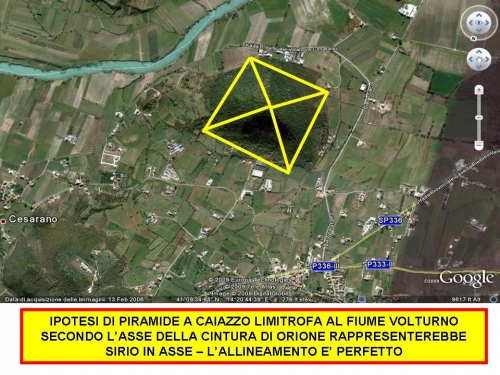 |
|
|
 Premier
Premier
 Précédent
2 a 9 de 24
Suivant
Précédent
2 a 9 de 24
Suivant Dernier
Dernier
|
|
| |
|
|
©2025 - Gabitos - Tous droits réservés | |
|
|

